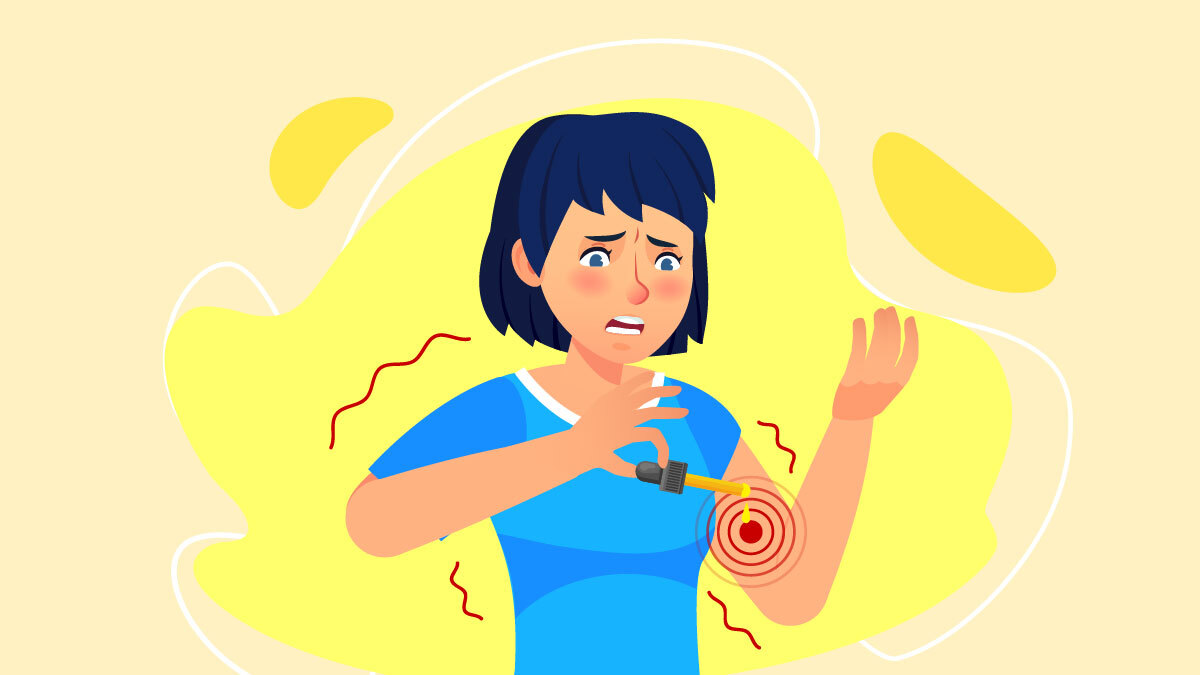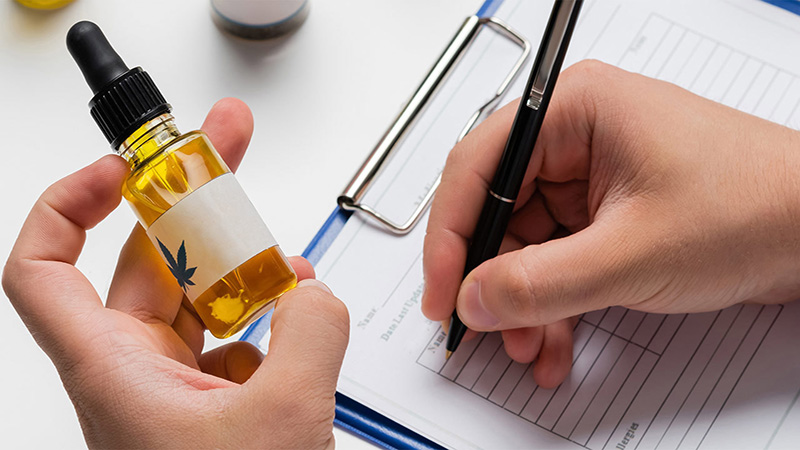Can I Rub CBD Oil on My Skin for Pain?

CBD oil has a myriad of potential therapeutic uses, but the pain is the most popular reason why people take CBD supplements.
The question is, can you rub CBD oil on your skin for pain?
This may sound like an appealing idea, but before you proceed, read this article so that you don’t waste your hard-earned money.
Today, we explain how CBD works for pain and whether you should rub it on your back.
Can I Rub CBD Oil on My Skin for Pain?
Yes, but that’s not the best way to use CBD oil for pain.
The reason is simple: when you rub CBD oil on your skin, it has poor bioavailability, not to mention the formula lacks other supportive natural painkillers from oil.
Rubbing CBD oil on your skin for pain may provide some relief, but it will be nowhere near the results you would have achieved with a CBD cream or another skin-dedicated product.
Why Is CBD Cream Better for Pain?
CBD is fat-soluble, meaning it dissolves in fats. That’s why CBD oils use carrier fats like MCT oil, and CBD creams are based on coconut oil, hemp seed oil, and fruit oils.
Since CBD creams include more fats than CBD oil, they will absorb better into the skin.
Another advantage of using CBD creams over oils topically is the level of moisture your skin receives from the said fats.
Not only can CBD creams ease pain and soothe irritation, but they can also help replenish the natural skin barrier by interacting with CB2 receptors in the endocannabinoid system.
Last but not least, CBD creams contain an array of supportive ingredients, such as natural analgesics (e.g. menthol, arnica, cayenne pepper), essential oils (terpenes), and regenerative compounds (e.g. manuka honey, aloe vera).
Together, these botanicals work synergistically with CBD, either enhancing or complementing its painkilling potential.
How to Use CBD Oil for Pain the Right Way

You can use CBD oil for pain, but make sure you pick the right format. As mentioned, rubbing CBD oil on your skin isn’t the best way to address physical discomfort.
However, you can support your natural pain resistance and thwart the causes of pain, such as inflammation, by using the following products.
We’ll explain the analgesic mechanisms of CBD later in the article.
Here are the best ways to use CBD for pain besides creams
1. Take Sublingual Drops
CBD oil drops are the most popular format of hemp supplements. It comes in glass bottles, with a dropper attached for accurate dosing.
To use CBD oil for pain, measure out the desired amount using the dropper — and transfer it under the tongue.
Once there, hold the oil for up to 60 seconds, swishing the tongue around the inside of your gums to increase the surface area for absorption.
You should be able to notice the first signs of relief around 20 minutes after ingestion.
If you suffer from chronic pain, CBD may need more time to start working. It’s best to test different doses for around 2 weeks to let your endocannabinoid system level its deficiencies.
2. Eat a Gummy
Gummies are the most enjoyable form of CBD. If you don’t like the taste of full-spectrum CBD oil or don’t want to mess with the dropper all the time, gummies are a perfect alternative.
A CBD gummy contains a fixed dose of CBD per serving. The sugars and juice concentrate mask the hempy aftertaste, making them fun and convenient to use.
With that said, CBD gummies have one downside. Namely, they kick in with a delay — around between 30 minutes and 2 hours.
But on the other hand, the effects last longer – around 8 hours – making CBD gummies a considerable pick if you’re looking for long-lasting pain management.
3. Vape CBD Resin
CBD vape pens offer the fastest and most effective way to deliver CBD to your system. They contain CBD distillate (a highly concentrated extract) and a blend of terpenes that pushes the effects in a specific direction. You can choose CBD vape resin infused with analgesic terpenes if you’re using CBD oil for pain.
However, despite their high bioavailability, the effects of CBD vapes are relatively short-lasting – up to 3 hours.
How to Rub CBD Cream on Your Skin for Pain
Let’s say you’ve bought a high-quality CBD cream for pain, and you want to rub it on your skin instead of the oil.
First, ensure you’re not allergic to any of the ingredients in the cream. Run a quick patch test by applying a tiny amount of the cream to the inside of your wrist.
If you don’t see any signs of irritation, you can use a larger amount.
CBD creams are difficult to dose. If you suffer from serious physical discomfort, you may need to use a more liberal amount a few times a day.
Generally speaking, it’s best to apply CBD cream for pain as needed. Topicals won’t prevent pain, but they can reduce the intensity of flare-ups.
Does CBD Oil Help with Pain?
Yes, pain is actually one of the best-researched areas when it comes to the therapeutic potential of CBD.
CBD has been touted as a novel anti-inflammatory drug, and its positive effects on chronic pain are well documented in the scientific literature.
Let’s look at how CBD targets pain — both its roots and the communication between pain messengers.
How Does CBD Work for Pain?
CBD stands for cannabidiol and is the modulator of the endocannabinoid system (ECS) – the primary self-regulatory network in all mammals.
The ECS is made from receptors, endocannabinoids, and enzymes; together, they work to promote and maintain homeostasis throughout the body.
The receptors of the ECS are found all over the body, with the largest concentrations in the central nervous system, immune system, blood cells, and peripheral organs.
The ECS controls essential homeostatic functions, such as mood, memory, body temperature, sleep cycles, immune function, appetite, reproduction, and pain perception.
Inflammation and pain signaling is mediated by both cannabinoid receptors – CB1 and CB2.
CBD & Resistance to Pain
CBD signals the ECS to produce more anandamide.
Anandamide is one of your main endocannabinoids, also known as the bliss molecule. It controls your reactions to fear, pleasure, and pain, on top of many other important functions.
Insufficient amounts of anandamide are linked with low hypersensitivity to pain.
CBD also inhibits an enzyme that breaks down anandamide, making it more available to the body.
With higher levels of anandamide in the bloodstream, the ECS may restore proper responses to pain in your body.
CBD for Inflammation
CBD offers significant anti-inflammatory properties. These effects stem from CBD’s interactions with the CB2 receptor.
Once CBD binds to it, the ECS inhibits the release of pro-inflammatory cytokines, reducing the occurrence and intensity of inflammation.
CBD can also suppress an overactive immune system in specific regions without shutting it down completely like conventional immunosuppressants.
Last but not least, CBD demonstrates immunomodulatory effects, improving communication between the cells of the immune system.
CBD & Pain Signals
CBD may alter pain transmission from the presynaptic nerve ends in the CNS to the postsynaptic nerve ends in the brain.
It does this by interacting with the TRPV1 receptor, the same receptor involved in seizure activity (that’s why CBD can help with seizures).
So, not only do you receive less pain from inflammation, but your brain also receives weaker pain signals.
What to Look for in the Best CBD Products for Pain

- Organic ingredients: both hemp and other ingredients should come from organic sources. Hemp is an effective bioaccumulator, meaning it will absorb and accumulate every substance from its environment. Other botanical ingredients in the formula may also be contaminated with pesticides and heavy metals if not sourced organically. These toxins may irritate the skin and mess with your nervous and immune systems.
- Additional painkillers: there are plenty of natural analgesics out there. Some of them enhance the painkilling effects of CBD, while others add an additional layer of relief on their own. Popular ingredients in CBD products for pain include menthol, honey, arnica, cayenne pepper, lavender, limonene, and aloe vera.
- Certificates of Analysis (CoAs): reputable companies test their products in third-party laboratories for potency and purity. The certificate of analysis contains the list of all ingredients in the CBD product, including common contaminants, such as the aforementioned pesticides, heavy metals, solvents, and mold. Only purchase from brands that publish these certificates on their websites or send them to customers with their orders.
Is CBD Safe?
Yes, CBD has a decent safety profile. Even doses as high as 1,500 mg taken daily for several weeks were well-tolerated by humans.
CBD may cause a few mild side effects in large doses, including drowsiness, dry mouth, changes in appetite, sedation, and diarrhea.
If you take any medications, talk to your doctor before buying CBD oil or cream for pain. CBD interacts with the majority of pharmaceutical drugs, so a consultation with a doctor will save you some undesired and potentially dangerous side effects.
Is it Legal?
Yes, CBD oil is legal in all 50 states as long as it comes from hemp. In 2018, President Trump signed the amended Farm Bill that removed hemp from the list of controlled substances.
Today, hemp can be grown and sold for any purpose — including health supplements like CBD oils and creams.
The only condition is that all hemp-derived products must contain 0.3% THC or less.
Final Verdict: Can You Rub CBD Oil on Your Skin for Pain?
Theoretically, you could rub CBD oil on your skin for pain, but it’s not worth the hassle.
CBD oil is made for sublingual uses, meaning you take it under the tongue for the best results.
Rubbing it on your skin only wastes its potential – there are skin-dedicated CBD products out there.
We recommend using a CBD cream or roll-on gel for pain. Common pain-relief formulas include ingredients like menthol, cayenne pepper, essential oils, and honey; all of them work alongside CBD to reduce discomfort.
Topicals are great for easing localized pain. For general pain management and wellness support, use other forms like vapes, oil drops, or gummies.
Sources:
- Lucas, C. J., Galettis, P., & Schneider, J. (2018). The pharmacokinetics and the pharmacodynamics of cannabinoids. British journal of clinical pharmacology, 84(11), 2477–2482. https://doi.org/10.1111/bcp.13710
- Nagarkatti, P., Pandey, R., Rieder, S. A., Hegde, V. L., & Nagarkatti, M. (2009). Cannabinoids as novel anti-inflammatory drugs. Future medicinal chemistry, 1(7), 1333–1349. https://doi.org/10.4155/fmc.09.93 [2]
- Argueta, D. A., Ventura, C. M., Kiven, S., Sagi, V., & Gupta, K. (2020). A Balanced Approach for Cannabidiol Use in Chronic Pain. Frontiers in pharmacology, 11, 561. https://doi.org/10.3389/fphar.2020.00561
- Kaur, R., Ambwani, S. R., & Singh, S. (2016). Endocannabinoid System: A Multi-Facet Therapeutic Target. Current clinical pharmacology, 11(2), 110–117. https://doi.org/10.2174/1574884711666160418105339
- Deutsch D. G. (2016). A Personal Retrospective: Elevating Anandamide (AEA) by Targeting Fatty Acid Amide Hydrolase (FAAH) and the Fatty Acid Binding Proteins (FABPs). Frontiers in pharmacology, 7, 370. https://doi.org/10.3389/fphar.2016.00370
- Henshaw, F. R., Dewsbury, L. S., Lim, C. K., & Steiner, G. Z. (2021). The Effects of Cannabinoids on Pro- and Anti-Inflammatory Cytokines: A Systematic Review of In VivoStudies. Cannabis and cannabinoid research, 6(3), 177–195. https://doi.org/10.1089/can.2020.0105 [6]
- Nichols, J. M., & Kaplan, B. (2020). Immune Responses Regulated by Cannabidiol. Cannabis and cannabinoid research, 5(1), 12–31. https://doi.org/10.1089/can.2018.0073 [7]
- Kaplan, B. L., Springs, A. E., & Kaminski, N. E. (2008). The profile of immune modulation by cannabidiol (CBD) involves deregulation of nuclear factor of activated T cells (NFAT). Biochemical pharmacology, 76(6), 726–737. https://doi.org/10.1016/j.bcp.2008.06.022 [8]
- Costa, B., Giagnoni, G., Franke, C., Trovato, A. E., & Colleoni, M. (2004). Vanilloid TRPV1 receptor mediates the antihyperalgesic effect of the nonpsychoactive cannabinoid, cannabidiol, in a rat model of acute inflammation. British journal of pharmacology, 143(2), 247–250. https://doi.org/10.1038/sj.bjp.0705920 [9]